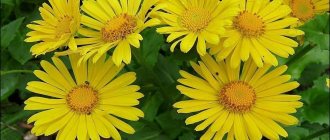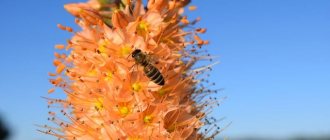Pyrethrum is a garden herbaceous perennial with flowers that look like multi-colored daisies. The simple “chintz” colors of this unpretentious plant harmonize perfectly with green lawns and wonderfully decorate spacious recreation areas and front gardens of country houses, requiring minimal attention. This is a flower for those who do not have the opportunity or desire to spend a lot of time caring for the site or who do not have the opportunity to visit it daily. In addition to decorative qualities, it can also perform a useful function - pyrethrum flowers, not only fresh but also dried, repel many harmful insects with their aroma, including garden pests and bed bugs.
Types of pyrethrum: girlish, pink and others
The exact number of types of pyrethrum has not been established, but there are several varieties that are suitable for home cultivation:
| View | Description | Flowers | Flowering period |
| Maiden | Perennial shrub from the southern regions of Europe. Branched, reaches 50 cm. The foliage is pale green, occasionally with tints of yellow. | Basket-shaped inflorescences, diameter about 4 cm. They can be regular or double. White and yellow. | Beginning of July – end of August. |
| Pink | Perennial growing in the Caucasus. It is grown as a biennial or annual. The stem is erect, with a height of up to 70 cm. It is one of the hybrid species. | Tubular or reed-shaped, bright yellow or pinkish in color. Buds up to 12 cm in diameter. | Mid-June – end of July. |
| Shield | Perennial, native to the eastern regions of Europe, the Caucasus. The trunk is straight, reaches 1 m. The basal foliage is about 40 cm long. | Inflorescences are corymbose, loose. Reed or tubular, yellow or white. | June July. |
| large-leaved | Perennial plant growing up to 1.5 m. | Small, formed into corymbose inflorescences. White, becoming reddish by mid-summer. | End of May – mid-July. |
And thanks to the fruitful work of breeders, several varieties of pyrethrum were also discovered:
| Varieties | Description | Flowers | Flowering period |
| Comedian | A hybrid with an erect trunk about 80 cm high. | Reed and tubular, bright red or yellow. | From July to August. |
| Robinson's Giants | The variety of pink pyrethrum is one of the most popular varieties of this plant. The trunk is straight, with a height of about 80 cm. Used for group plantings, ridges, and also for cutting. | Reed. Color: pink or carmine. | Mid-June – second half of July. |
| Golden ball | Derived from maiden pyrethrum, it belongs to the decorative varieties. Perennial, but in Russia it is grown as an annual. Grows up to 25 cm. | Terry, spherical in shape. Bright yellow color. | June July. |
| Troubadour Reeds. | A variety of pink pyrethrum. Used to decorate flower beds. | Color - from white to red. | The next year after sowing (mid-June). |
| Scarlet Star | Perennial plant up to 80 cm high. | Tubular (yellow) or reed (deep red). | Mid June – July. |
| Harmony | A variety of pink pyrethrum, with a 70 cm trunk. | Terry. Color – yellow or red. | Mid June – August. |
Outdoor care
In a normal summer, pyrethrum may get enough moisture from precipitation. During the dry season, the plant will require additional watering, otherwise the flowers will become smaller. Pyrethrum should be watered sparingly, without waterlogging the soil.
The plant blooms without additional fertilizing, but if you grow pyrethrum on fertile soil, it shows the best varietal qualities and forms a lush bush.
The long stems of the plant can break off from wind or heavy rain, so they should be tied up.
Pyrethrum is not overrun by weeds, so it does not require constant weeding. The soil around plant bushes is loosened after rains or watering so that a crust does not form on the surface of the soil.
In the fall, all the stems of perennials are cut off and covered. But pyrethrum can survive the winter without shelter if it is kept under a gentle cover in winter.
Growing pyrethrum from seeds
Persian or Dalmatian chamomile (another name for pyrethrum) is effectively propagated by seed. But with such dilution, the color of the buds can turn out unpredictable.
You can grow pyrethrum using seeds in the following ways:
- planting seedlings;
- direct landing in open ground.
When using seedlings, the seeds are sown in early spring, then in May the seedlings are already placed at the final growing site. Since this planting material is quite small, professionals advise mixing it with sand and then covering it with a little soil. Pots with seedlings are covered with film to create a greenhouse effect. Shoots appear within a week.
After 3 true leaves appear, the seedlings are transplanted into separate pots. For a month, provide a temperature of +20 °C.
Seeds are planted in open ground in May-June. When seedlings emerge, the seedlings are placed so that the gap between them is about 20 cm.
Botanical description
Pyrethrums are mostly perennial plants, although there are also annual species in the genus. The stems of pyrethrums are ascending or erect, ribbed, branched and pubescent, reaching a height of 60 to 100 cm. Representatives of the genus have a powerful root system, penetrating 3 meters deep. The arrangement of gray-green on the upper side and ash-gray on the lower side, dissected into more or less narrow segments, of pyrethrum leaves is regular. The basal leaves have grooved petioles that are twice as long as the leaf blade, while the petioles of the stem leaves gradually shorten towards the top of the stem. Single baskets of pyrethrums with a diameter of 5-6 cm, collected in apical corymbose inflorescences, consist of small median bisexual tubular and sterile ligulate marginal flowers, white, red or painted in various shades of pink. The pyrethrum plant blooms in May-June. Its fruit is a light brown achene with 5-10 ribs and a lobed or toothed crown. Pyrethrum seeds do not lose their viability for 2-3 years.
Planting pyrethrum
It is recommended to sow seeds or seedlings in the ground in late spring or early summer, when the threat of frost has passed.
They prefer well-lit areas, although Persian chamomile feels comfortable in partial shade. With a lack of light, the trunks stretch, thereby reducing the abundance and duration of flowering.
The flower is undemanding when it comes to soil, but it is recommended to choose permeable soil, because Dalmatian chamomile does not tolerate stagnant water. In acidic soil, add ash or lime.
Caring for maiden chamomile
Place. Maiden's chamomile is light-loving, but grows well in partial shade. It is planted in flower beds, flower pots and balcony boxes. Gardeners who favor environmentally friendly methods of pest control can leave a few bushes under garden trees, next to shrubs and in vegetable beds.
The soil. Maiden chamomile has no special predilections for the composition and structure of soils, although luxurious bushes often grow on fertile garden soils. Seedlings of maiden chamomile feel good even between paving slabs, in cracked blind areas, near humus heaps or, unexpectedly for everyone, they end up in flower pots with indoor plants.
Watering. Pyrethrum maiden steadfastly tolerates temporary drought. But prolonged waterlogging is dangerous for him.
Winter hardiness. Maiden's chamomile easily tolerates spring and autumn frosts. In winter, its bushes often do not freeze out, but get wet. Once on our site, in the place where at the end of summer a delicate lawn of numerous young daisy bushes had turned green, in the spring a huge heavy snowdrift did not melt for a long time. When the snow completely melted, it turned out that only a few withered bushes remained from the emerald carpet. I had to clean the area with a rake and sow lawn grass.
Trimming. A maiden chamomile bush will bloom continuously and for a long time if all faded inflorescences are regularly removed. It is easier and faster to cut off the faded top part with garden shears.
Reproduction. Maiden chamomile is replanted even at the moment of flowering. The main thing is to preserve the earthen lump. Dividing adult overgrown bushes is a simple and accelerated propagation option. The seed method is also simple. Especially when the plant itself does this: its self-seeding will appear in a variety of places. Seedlings grow very quickly, they tolerate transplantation well and easily settle into a new place. Flowering begins 80 - 100 days after emergence.
Maiden chamomile bushes grow everywhere
Pyrethrum propagation
In addition to planting seeds, the plant is propagated by dividing the bush and cuttings.
The first option for breeding pyrethrum is carried out once every 3-4 years; by this period, the flower is actively growing lateral processes. To do this, the bush is removed from the soil and excess soil is removed from it. The division is done manually. The resulting parts must be large; they are placed in holes and watered abundantly.
Cuttings are obtained from young root shoots, from late spring to August. Then they are transported to nutritious and airy soil for rooting, the container is placed in partial shade. The earth is constantly moistened, and to reduce evaporation, the shoots are covered with film. Ventilate and irrigate daily. Rooting occurs between 14 and 21 days. Then they transplant into the garden.
Features of care
The plant is unpretentious, so the main difficulties are planting and growing young seedlings. Care for feverfew includes:
- watering;
- mulching;
- loosening and weeding;
- fertilization;
- pruning;
- protection from diseases and pests.
Loosening and weeding are required only at the beginning. Later, the bushes grow strongly and themselves suppress the growth of other plants. For this reason, the development of pyrethrum should be curbed when it begins to interfere with neighboring crops.
Mulching prevents moisture evaporation and the formation of a dense earthen crust. Pruning is mainly carried out sanitary, when dried, broken shoots and faded inflorescences are removed.
Watering requirement
During drought, the leaves become small, turn brown, and the flowers quickly fade. To preserve its decorative properties, feverfew should be watered in a timely manner. Overwatering threatens the development of root rot, so it is also undesirable. For this reason, the recommended frequency of the procedure is 1 per week; in extreme heat, the frequency of watering should be increased to 2-3.
Feeding
If the variety is grown for cutting, fertilizer must be applied to ensure large inflorescences. You can use universal mixtures for flowering crops. Combine the operation with watering so as not to burn the root system.
Of the folk methods, the use of herbal infusions has shown good results. To prepare it, take the weeds, add water, and leave them in the sun for 2-3 days. It is advisable not to use bird droppings or humus in their pure form, so as not to make the soil too acidic.
Diseases and pests of pyrethrum
As pyrethrum grows, it is susceptible to insect attack and disease:
| Symptoms (effect on foliage) | Disease/pest | Corrective measures |
| Fluffy gray coating, trunk deformation. | Fusarium. | Affected flowers are removed from the ground and burned. The area where the plant was grown is treated with any fungicide. |
| Holes. | Slugs. | Collected by hand. Correct the irrigation regime, preventing water stagnation. |
| Wilting, white spotting. | Thrips. | The plant is removed from the ground and thrown away, the soil is sprayed with a systemic fungicide. |
| Yellowing. | Aphid. | In case of severe damage, pyrethrum is removed from the soil and removed from the site. If there are a small number of pests, the bush is treated with Insecticides (Aktellik, Aktara or Biotlin). The actions are repeated 2-3 times. |
Dalmatian chamomile Wikipedia. Features of Dalmatian chamomile
To distinguish Pyrethrum cinerariaefolium Trev from other varieties, it is necessary to determine its external characteristics and chemical composition.
Root system
Pyrethrum has a strong root system with a tap root growing up to 3 m. If the soil is soft and loose, additional branches are formed on the sides, growing to the sides and then going deeper. The base of the rosette is overgrown with many adventitious roots. The pharmaceutical type is characterized by a tap root with weak branching.
Ground part of the plant
Dalmatian chamomile bushes grow luxuriantly, creating numerous stems with ribbed edges and pinnately dissected leaves in three places. The individual parts of the leaf plate resemble a blade with two or three branches. The tip of each blade is rounded. The bottom of the leaf plates are covered with silver-gray fibers. The shade at the top of the leaves varies from bright green to gray. The splendor of the leaves and the numerous stems gives the impression of density and density of the bush.
Bloom
Pyrethrum blooms in separate baskets, consisting of false-ligulate marginal white flowers and yellow central tubular flowers. The baskets are placed on top of the stems, resembling the shape of a chamomile. But the flowers of this species reach a diameter of 4-5 cm, which is much larger than that of its “rival”. If we compare the two types of plants, the hemispherical center of medicinal chamomile and the flat center of pyrethrum catches the eye. When the flower is cut vertically, the pyrethrum does not have a cavity, which the pharmaceutical type has.
Fruit
When Pyrethrum cinerariofolia fades, seeds 5 mm long and 1 mm wide are formed. They have a yellow-brown tint and a ribbed shape. Chamomile has smaller, cylindrical, silver-gray seeds.
External similarity does not make two types of chamomile close relatives. They belong to different families and differ in biological properties.
Mr. Summer Resident advises: pyrethrum in landscape design
Used in carpet-type flowerbeds for edging. In this situation, the bushes are trimmed to the required height and prevent the formation of buds.
They are also used to decorate borders. Bright colors improve the appearance of borders and mixborders.
This shrub is considered the most optimal for decorating a garden in a country style. This is explained by the fact that the flower looks great and takes root nearby with ornamental plants.
The flower is used to decorate loggias and terraces. It is also suitable for arranging bouquets.
Useful properties of pyrethrum
In the old days, Dalmatian chamomile was used to lower fever, eliminate inflammation and headaches. It has been proven that this flower has properties similar to aspirin.
In the 1980s, scientists noted feverfew as an effective substance in the fight against migraines. It was said that the powder of this plant relieves severe and frequent headaches much faster than expensive medications. This was explained by the fact that the flower contains parthenolide, which helps block the synthesis of serotonin. And, as you know, excessive content of this component in brain cells and blood vessels is recognized as the cause of migraine formation.
In addition, Dalmatian chamomile blocks the production of histamine, prevents the formation of blood clots in blood vessels, and has antimicrobial and anti-allergenic properties. The leaves are used to create applications against arthritis and rheumatism, and are used to treat asthma and relieve pain during the menstrual cycle.
In combination with medications, feverfew eliminates allergic manifestations of dermatitis and psoriasis.
This plant has an unusual appearance and medicinal properties, which attracts a large number of gardeners. Decoctions from this flower are often given to young children with allergies accompanied by severe rashes.











